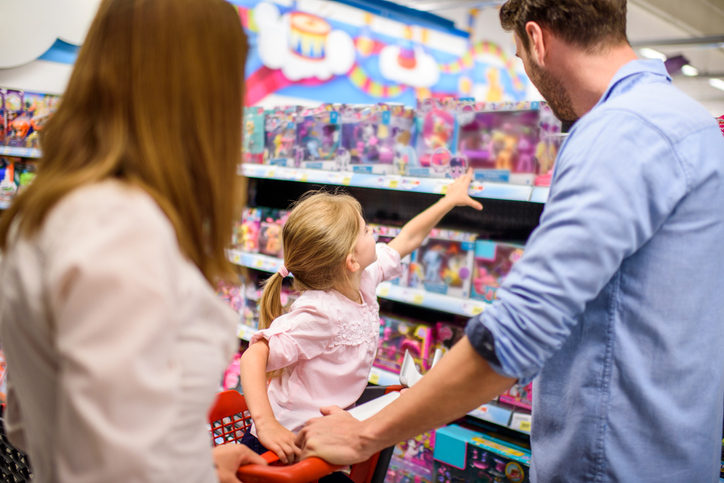Toy Shoppers Come Down With a Case of the Holiday Blahs
Sales of toys and games slump as Americans show signs of pulling back
Shoppers couldn’t get enough toys and games during the pandemic. Now, they are finding other ways to spend their time, and that is spelling trouble for toy makers and sellers.
Sales of toys have slumped so far this year, down 8% through September compared with the same period last year, according to market-research firm Circana, and appeared poised to be lacklustre this holiday season. Imports of toys and games have fallen sharply this year and sales at toy stores, department stores and other gift sellers declined in October, leading a broader pullback.
A retrenchment on the most fun-to-give gifts sends a signal that Americans are starting to ease their spending more broadly as pandemic savings dwindle, the labor market softens and shoppers worry about global events and still-elevated inflation. Easing consumer spending would cool overall growth, because it accounts for more than two-thirds of economic activity.

This holiday season is off to a slow start for Wildlings Toy Boutique in Phoenix, which sells classic toys dollhouses and wooden cars and accessories. The store has been trying to drum up customer interest with experiences, including Santa visits and family photo shoots in front of a Christmas-tree backdrop outside the store.
“I think people are reluctant to spend as much and to spend as early,” said owner Jennifer Mawcinitt, who expects people to come in looking for deals on Black Friday.
Larger retailers are seeing similar trends.
Customers are “showing ongoing discretion and making trade-offs to be able to afford the things they want, given the sustained high cost of the things they need,” Walmart Chief Financial Officer John David Rainey told analysts last week.
Experiences valued over things
Early in the pandemic, when many were unable to travel and dine out, Americans shifted their spending toward goods, including toys, games and electronics. That has reversed.
Spending on services has grown roughly double the pace of goods for most of this year as consumers caught up on experiences such as concerts and trips to Europe.
Fewer board games and puzzles are coming off toy store shelves because “people are going outside,” said Katherine Nguyen, owner of Building Blocks Toy Stores, which has three locations in Chicago.
Nguyen is seeing an exception: Shoppers can’t wait to get their hands on toys they can squeeze, such as the Bitzee digital pet and Squishable plush toys. “I don’t have a store big enough to sell” all the stuffed animals now in demand, Nguyen said. She added that those toys are popular in part because they are geared toward social and emotional self-care as children navigate post pandemic life.
Hannah Sweet, a retired care manager in Tiburon, Calif., said she is more cautious about spending this holiday season than in previous years, pointing to concerns about an economic downturn. Economists surveyed by The Wall Street Journal last month put the probability of a recession in the next year at essentially a coin flip.
“I am prioritising gifts to children and grandchildren,” said Sweet, 81 years old. Still, she recently took a trip to Germany and next year plans to go on a river cruise in Europe with family. “It’s important to travel while I can,” Sweet said.
The National Retail Federation, a trade group, expects November and December holiday spending to rise 3% to 4% this year from last, or hold about flat when factoring in inflation. That would be slower than a 5.4% increase in 2022 and a 13% rise in 2021.
Expecting potentially weaker demand, retailers and other sellers ordered fewer toys and other popular gifts from overseas. U.S. imports of toys, games and sporting goods dropped 21.5% in the nine months through September, compared with the same period a year earlier, according to the Commerce Department. Bicycle imports fell more than 40%; smartphones declined 16%.
Toy companies struggled to clear out bloated inventories in 2022 after supply-chain snags left retailers with extra stock. Barbie maker Mattel warned that rising prices across the economy and high borrowing costs would likely continue to dent demand for toys this holiday season. Chief Executive Ynon Kreiz said last month that overall industry sales would fall by a mid-single-digit percentage for the full year.

Hasbro, the maker of Monopoly, Play-Doh and Transformers action figures, reported a 10% drop in revenue in the third quarter and cut its full-year guidance because of weak demand.
“We have a cautious outlook on the holiday,” Hasbro Chief Executive Chris Cocks said on a call with analysts. “And I think anyone who says they know how the holiday is going to go, they must have a crystal ball because this has been a tough one to predict.”
Hasbro expects consumers to wait longer to make their purchases and to look for more deals. Some deals are already emerging. Toy prices fell nearly 4% in October from a year earlier, the Labor Department said.
Consumer concerns emerge
Shoppers are facing a number of headwinds that threaten to curtail holiday cheer this year.
Hiring slowed sharply in October and the unemployment rate has risen this year. Paying down credit-card bills is more difficult with interest rates at two-decade highs, and student-loan payments resumed for millions of borrowers. Consumer sentiment in November fell to the lowest level in six months, the University of Michigan said Wednesday.
Americans’ downer attitudes on the economy might not transfer to slashed spending. Many economists saw signs that elevated interest rates would cause consumers to ease up earlier this year. Instead, they spent lavishly, causing economic growth to accelerate.
“Overall, the consumer has been very resilient: that’s why we’re not in a recession,” said Sucharita Kodali, a retail analyst at Forrester.
Nguyen, the owner of Building Blocks, remains optimistic about this holiday season. “People don’t cut out their children,” she said. “Even if they have job insecurity, or worry about food costs,” they still buy gifts for their children, she added.
—Anthony DeBarros contributed to this article.
 Copyright 2020, Dow Jones & Company, Inc. All Rights Reserved Worldwide. LEARN MORE
Copyright 2020, Dow Jones & Company, Inc. All Rights Reserved Worldwide. LEARN MORE
This stylish family home combines a classic palette and finishes with a flexible floorplan
Just 55 minutes from Sydney, make this your creative getaway located in the majestic Hawkesbury region.
Money worries are having a cascading effect on stress levels, conflict and even the rate of ageing
Worrying about the cost of living is causing accelerated ageing, household arguments and creating significant stress, according to new research. More than half of Australians say they have experienced personal setbacks due to financial strain over the past year. Almost 20 percent say that have suffered a stress-related illness, 33 percent have lost sleep and almost one in five are seeing signs of early ageing.
Household hostility is also rising, with 19 percent of Australians admitting they have argued with their partners about money, and a further one in 10 have argued with family and friends.
The Finder survey of 1,070 Australians reveals women are bearing the brunt of financial stress, with 62 percent reporting they have worried about money compared to 42 percent of men.
Younger Australians are struggling the most, with almost 7 in 10 Gen Z respondents reporting financial strain compared to 58 percent of Gen Xers and 24 percent of baby boomers.
The impact of cost-of-living pressures among different age groups and income levels is reflected in new data from the Australian Bureau of Statistics (ABS). The selected living cost indexes show employee households are under more strain from inflation, with the CPI measure for this population group at 6.5 percent today compared to the official overall CPI figure of just 3.6 percent.
The discrepancy is due to higher mortgage interest payments – which make up a higher proportion of expenditure for employee households — as well as an increase in primary and secondary school fees, and the indexation of tertiary education fees at the start of the year. The official CPI does not include mortgage payments, so the living cost indexes provide a more accurate picture of how rising interest rates are impacting households with mortgages today.
The inflation rate is much lower for older Australians, who have often paid off their mortgages. The inflation rate on living expenses for age pensioner households is below the official CPI level at 3.3 percent, and it’s only slightly higher at 3.4 percent for self-funded retirees.
Graham Cooke, head of consumer research at Finder, said that despite cooling inflation, Australians were still under significant financial pressure.
“This can be seen in Finder’s Cost of Living Pressure Gauge, which has been hovering in the extreme range for the past year and a half,” Mr Cooke said. The gauge returned a reading of 78 percent in March this year compared to 47 percent in March 2021, when inflation was 1.1 percent and the Reserve Bank’s official cash rate was 0.1 percent.
Interestingly, Australians’ cash savings are higher today than they were in 2021, likely reflecting stimulus payments received and saved during the pandemic. The Reserve Bank has cited pandemic savings as a factor in keeping mortgage arrears low despite much higher interest rates. The Finder research shows Australians have an average of $37,206 in cash savings today, up from $24,928 two years ago.
“Money concerns can cause problems in your everyday life and snowball quickly if you don’t get them under control,” Mr Cooke said. “Building financial resilience is as vital as ever as costs continue to rise. Pay close attention to where your money is going so you keep impulse spending to a minimum, and don’t overspend.”
Australians appear to be heeding this advice, with the latest ABS retail figures showing seven straight quarters of declining per capita spending. “Per capita volumes show retail turnover after the effects of inflation and population growth have been accounted for,” explained Ben Dorber, ABS head of retail statistics. “Following an unprecedented seven straight falls, it is very clear how much consumers have pulled back on spending in response to cost of living pressures over the past two years.”
Just 55 minutes from Sydney, make this your creative getaway located in the majestic Hawkesbury region.
This stylish family home combines a classic palette and finishes with a flexible floorplan






















